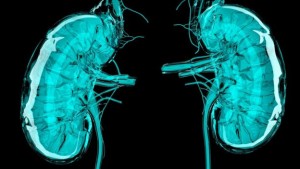Miniature human kidneys have been grown in a Petri dish using stem cells as the starting point, report scientists in Australia. The mini-kidneys, measuring up to 1cm, were the equivalent of the developing organ in a 13-week-old foetus. The team say the findings, published in the journal Nature, could lead to new ways of testing drugs and eventually a way of replacing damaged kidneys. Experts said there was still a long way to go.
The scientists were mimicking the process that takes place inside the womb when a single fertilized egg produces the whole array of precisely arranged tissues of the human body. Their starting point was human skin cells that had been chemically transformed into a type of cell capable of becoming any other a stem cell. The team used chemical signals to transform the stem cells into two types of cell. One goes on to produce the structures that filter the blood and the other the collecting ducts that remove the waste. When the two cell-types were brought together in a dish they grew and arranged themselves into the complex structure of a kidney. The mini-kidneys are so small they cannot be termed organs. The “organoids” contained between 50 and 100 filters while an adult kidney has more than a million
Prof Melissa Little, one of the researchers from the Murdoch Children’s Research Institute, told the BBC News website: “We’ve been able to show we can take human stem cells and in a dish make a structure like a small developing kidney. “The aim in the very long-term is to see if we can recreate an organ that would be good enough to treat someone with kidney disease.” However, as the growing organoids do not have a blood supply there is still a long way to go before full-size organs can be grown in the lab.” This is what we can get to in three weeks, but there is a limit to what you can grow in a dish without nutrients and oxygen,” Prof Little added. It marks the latest development in a process of growing organoids which has already seen the development of mini-brains and livers. Prof Jamie Davies, from the University of Edinburgh, commented: “It is vital to emphasize that the result of this process is not a kidney, but an organoid, it lacks large-scale features that are crucial for kidney function.
“There is a long way to go until clinically useful transplantable kidneys can be engineered,” but however, he said “the organoids could be used to test the toxicity of new drugs and could mark a “major step” towards replacing animals in such experiment study is a valuable step in the right direction.” Published in the journal Nature, the results have significant implications for medical research, as the mini-organ mimics normal kidney development. It means laboratory-grown kidneys can be used for drug testing and potentially the bioengineering of replacement kidneys for patients with renal failure as they can be grown from any person using cells such as skin or blood.
It also opens the door for cell therapy and other new treatments for kidney disease not to mention giving researchers a chance to grow ‘kidney models’ to learn more about how the human kidney forms normally.”For us it’s a pretty exciting advance,” said stem cell biologist Melissa Little, of the Murdoch Children’s Research Institute. “This organ is making its own blood vessels, it’s making its own tubules for filtering and cleaning the blood, so it’s really a very complex structure,” she said of the kidney, which was observed three weeks after creation. An author on the paper, Professor Little said it was equally important to learn how healthy and diseased kidneys functioned but that ethical reasons often limited research on human kidneys. Instead mice were used. However, she said while the mouse kidney was similar to humans, it was structurally different.
“Now for the first time we have a chance to ask what is different between a human and a mouse kidney because we don’t study human kidneys for obvious reasons,” she said. “From a research point of view it is going to tell us a great deal more than we knew before.” About half the children with kidney disease had inherited the condition via a genetic mutation. Being able to grow a kidney using a patient’s stem cells meant a diseased kidney could be grown to test a patient’s response to treatment before drugs were administered.
For more information please visit: www.bbc.com

